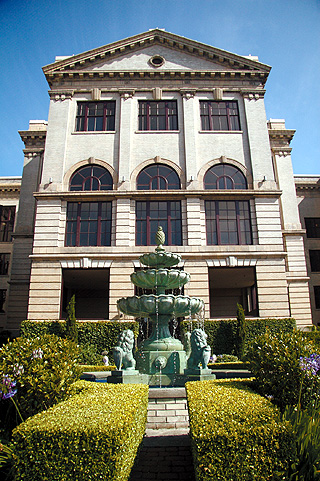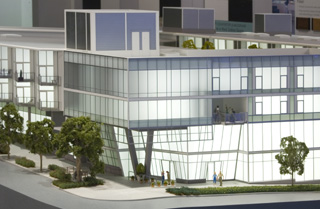
Surveys
DJC.COM
October 26, 2006
Queen Anne readies for icons old and new
Special to the Journal

Nicholson
|

Winningham
|
Anyone trying to determine the truth behind the adage that the more things change, the more they stay the same need not look beyond Seattle’s Queen Anne neighborhood. Queen Anne, one of Seattle’s first communities, is home to two distinct developments: Lumen, a modern mixed-use development that is a landmark in the making, and Queen Anne High School Condominiums, a historic property that is one of Seattle’s well-known landmarks.
Despite their very different architectural styles, certain aspects of their designs are strikingly similar. The most obvious similarities are the large windows, tall ceilings and open floor plans.
Queen Anne High School combines classic beaux-arts detailing and a prominent hilltop location with innovations in construction that were rare to the region in 1909. These innovations include fireproof construction, large windows and advanced heating and ventilation techniques. Upon its completion, Queen Anne High School was hailed in a school board report as having “marked the summit of achievement thus far in Seattle school architecture.”

Photo courtesy of Queen Anne High School Condominiums Restoration work planned for the exterior of the former Queen Anne High School includes terra-cotta and masonry repairs, and a good cleaning. |
Creating an icon
Lumen, created by Seattle architect David Hewitt and interior designer Garret Cord Werner, marks an achievement in contemporary architecture in Queen Anne. Some homes at Lumen have floor-to-ceiling windows that are almost 20 feet tall.
From a marketing standpoint, though, a great building is about more than just big windows and soaring ceilings. Ultimately, it’s about the uniqueness of a project. People have always wanted to live in iconic landmarks. Outside of personal taste, it doesn’t matter whether the address is iconic because it’s historic or unmistakably modern. What matters is that the homes are unlike anything else.
An old building stands out
At Queen Anne High School, which Legacy Partners is converting from apartments to high-end condos, the palette is undeniably unique. How many people can say they live in an old schoolhouse that is one of only 37 Seattle buildings on the National Register of Historic Places?

Image courtesy of Lumen Lumen will use translucent exterior walls to allow light in but maintain residents’ privacy. |
But just because the building has historic stature does not mean that there wasn’t further work to be done to make the property truly stand out. The project architect, Johnson Architecture & Planning of Seattle, worked with the Seattle Landmarks Preservation Board to obtain approval for any changes and renovations to the building’s exterior. The firm’s Susan Upton is the project lead.
Fortunately, the work that Legacy is doing on the exterior of Queen Anne High School is minimal. The company is restoring the masonry, repairing the terra-cotta and extensively cleaning the exterior.
Legacy is making one significant alteration on the courtyard side of the property. When Queen Anne High was turned into apartments 20 years ago, an addition was built. This new building was clad in tan stucco, which has drastically deteriorated. Although the least costly alternative was to repair or replace the stucco, Legacy decided to invest in the architectural integrity of the overall project by cladding the addition with light-gray brick. The crisp, clean look — though similar to the property’s other facades — will allow observers to distinguish the new wing from the others while still complementing the other facades.
During the 1986 renovation, much of the interior of the schoolhouse was significantly altered. Sadly, the grandeur of the original wide halls was a casualty. But some features, such as the Galer Street entrance, remain. Legacy has revamped the majestic entry, which is 28 feet wide and 18 feet high, making it elegant but not so ornate as to erase the memory of the original use of this space as a school entrance. The goal is to reintroduce interior classic elegance that considers the original neoclassical statement of the exterior.
As for the residences, Legacy is preserving what gives the homes their character — the original hardwood floors and, in some cases, the blackboards — while giving homes modern condo finishes.
A modern landmark
Lumen is distinguishing itself with its overall ultramodern design, as well as its overall development concept. The brainchild of Landstar, Lumen is a unique concrete low-rise building on a full city block and is encased in glass and white steel. The extensive use of translucent exterior walls allows light in but maintains residents’ privacy. These and other elements show how out-of-the-box thinking fueled the design.
Located in a neighborhood of architectural icons — including the Space Needle, Experience Music Project and the planned headquarters of the Bill & Melinda Gates Foundation — Lumen was designed to complement its neighbors by being an icon, too. Clearly, there will never be another residential development like Lumen in Seattle.
The highly engineered residences at Lumen maximize space with specially designed cabinets and moveable walls. These full-height moveable wall panels give residents extraordinary design flexibility to expand and change their interior spaces. In addition, adjustable furniture storage systems allow residents to make home offices appear or disappear quickly, and beds on hydraulic lifts offer easy access to ample under-bed storage.
Relating to the neighborhood
Another important aspect of building a unique project is community planning and its relationship to the neighborhood. The depth of neighborhood involvement and planning is evident at Lumen, which is bringing some much-needed retail to the area.
Lumen will have 75,000 square feet of retail, including Quality Food Centers’ newest urban concept store, which will be the national flagship for parent company Kroger. In addition, a number of national retailers will be announced soon.
Lumen addresses the community’s desire for market-rate housing and high-quality retail collected in an efficient and architecturally significant package that fits into its location. Landstar is confident that Lumen will be an instantly recognized name in the city, because it is a modern spin on the proven elements that make a neighborhood successful.
Members of the Lumen team call the style of the project “lifestyle condominiums” and believe the concept is a harbinger for future urban development where urban scale is balanced with a sense of community. When closely examined, Lumen is a new neighborhood considering that it would cover more than six full city blocks if it were a single-story development.
As with any new residential development, the success of the project hinges on its ability to stand out. Whether it’s new construction or adaptive reuse, or whether the type is commercial, office, residential or mixed-use, the market always has rewarded something unique. And it always will.
Kerry Nicholson is senior vice president of Legacy Partners, a leader in western U.S. commercial and residential real estate. Alan J. Winningham is a principal of Landstar Real Estate. He and his business partner, Gerhard Kleinschmidt, have developed several million square feet of community-inspired projects.
Other Stories:
- Victoria project goes from brown to green
- Should design firms grow and change?
- Retail plays a bigger role in mixed-use
- In with the old, in with the new
- Designers bet urban dwellers want more
- Dream team designs downtown penthouses
- Designing a cancer center for 4 competitors
- Healthy buildings’ role in organic modernism
- Keeping the bad guys out of banks
- Surviving today’s tough bid climate
- Why marketing during the good times is critical
- Getting creative with your feasibility analyses
- Hotels and condos: mixed-use matrimony
- School’s design reflects its humanist curriculum
- Seattle’s waterfront: 100 years of hidden history
Copyright ©2009 Seattle Daily Journal and DJC.COM.
Comments? Questions? Contact us.